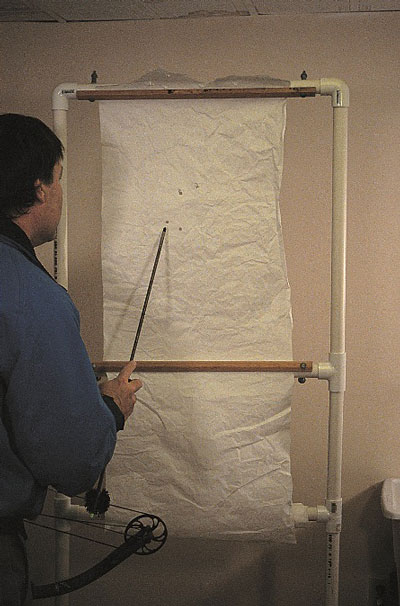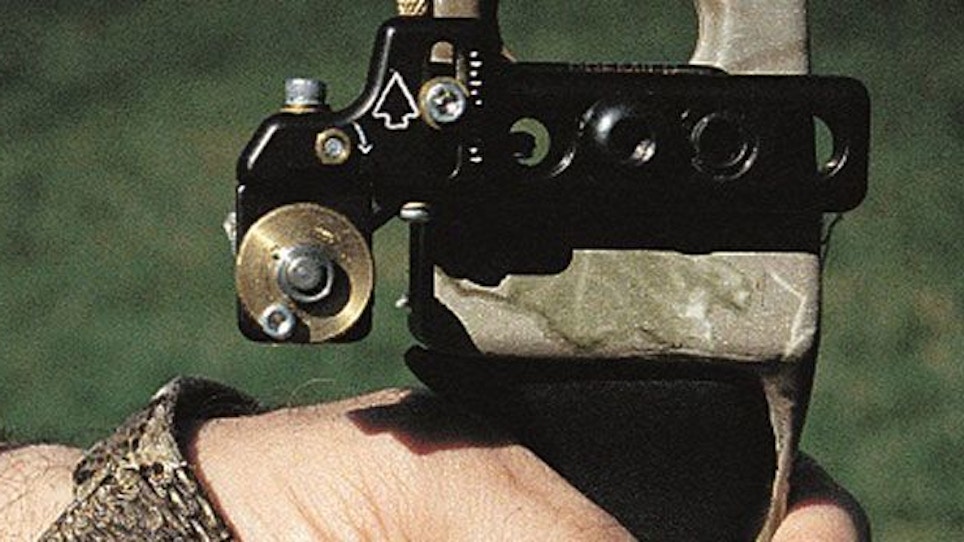Previously: Timing & Orientation, Strings, Draw Length
Rests
Assuming arrows are properly spined, the rest is arguably the most critical component in tuning. Any solid, durable rest can be made to work well, but if you want to simplify the tuning job, don’t scrimp on the rest. Get a good, micro-adjustable rest. (For our purposes here, micro-adjustable rests are rests that have fully separate adjustments for lateral and vertical movement, and that are calibrated with visible location markers.)
 Dampening Devices
Dampening Devices
One downside of short bows is that they are more subject to torque upon release—that is, they are more likely to turn or jump laterally in the hand as the arrow is released. Bow-makers have addressed this problem by including weights, or dampening devices, on the limbs of the bow. Properly positioned away from the grip, they can in effect simulate longer limbs. And while single-cam designs tend naturally to be quieter, these aftermarket devices further reduce recoil, shock, and noise.
Shooting Form
A fast bow is a fast bow, whether it’s a single-cam or a double-cam. And fast bows are less forgiving bows. You won’t even be able to tune them well if you don’t have reasonably good shooting form. The ins and outs of perfect shooting form are beyond the scope of this column, but there are two components of shooting form that often give rise to problems.
The first is grip. High grip, low grip, medium grip? It’s going to vary from one shooter to another, and even from one bow to another. The important thing is to find a comfortable grip that you can maintain consistently and that works for you. For years I favored a high grip, and it seemed to work for me—at least until bows got lighter, shorter, and faster, when I sometimes found myself spreading arrows horizontally across the target face. A fellow watching me at the range one day casually suggested I try a lower grip. I did, and the group tightened up as if by magic. That is not to say that a lower grip is better than a high grip—only that for me, with that bow at least, it was the solution to the problem.
Since then I’ve learned to always shoot with a glove on. My buddies think I’m overdoing it a little, but I’ve learned it’s the best way for me to get a consistent grip, since with the glove on, the bow grip always slides into the same spot on my hand. Without the glove, the grip sticks where I touch it, and I’m constantly shifting around looking for the sweet spot that I never quite seem to find with consistency. Try it—it might work for you.
Tight grip, loose grip? No contest here. A loose, comfortable grip is the way to go. You needn’t open your fingers completely, though if this will prevent you from grabbing the bow after the shot, it’s probably worth trying. Most experienced shooters settle into a loose grip with the forefinger lightly touching the thumb. The hand, and indeed the entire arm holding the bow, should be relaxed, the elbow unlocked.
 The second bugaboo for many shooters is follow-through. The thing about follow-through is that it is very easy to think you are doing it when you are not. You can chant “follow through” like a mantra before, during, and after your shot and swear that you’re following through, while anyone observing you knows that you’re not. It may be a problem of grabbing the bow after the shot to avoid dropping it. This is a pernicious habit, but one that can usually be cured with a little concentration and a wrist sling.
The second bugaboo for many shooters is follow-through. The thing about follow-through is that it is very easy to think you are doing it when you are not. You can chant “follow through” like a mantra before, during, and after your shot and swear that you’re following through, while anyone observing you knows that you’re not. It may be a problem of grabbing the bow after the shot to avoid dropping it. This is a pernicious habit, but one that can usually be cured with a little concentration and a wrist sling.
Grabbing the bow isn’t always the problem, though. Sometimes it’s as simple as lowering the shooting arm too quickly after the shot. Again, shooters aren’t always conscious of this problem. The trick is to maintain the shooting form until well after the arrow has hit the target. I find that if I concentrate on maintaining eye contact with the target until the arrow has hit home, I tend naturally to follow-through the shots.
Looked at in the context of trends toward faster, lighter, shorter, and hence more-difficult-to-tune bows, single-cams can be looked upon as a Godsend. Combined with new, high-quality, low-stretch strings, they significantly decrease the amount of time bowhunters must spend tinkering with their bows as opposed to hunting with them.






